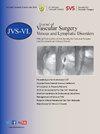胸廓出口静脉减压术的管理和疗效:向锁骨下入路过渡。
IF 2.8
2区 医学
Q2 PERIPHERAL VASCULAR DISEASE
Journal of vascular surgery. Venous and lymphatic disorders
Pub Date : 2024-08-03
DOI:10.1016/j.jvsv.2024.101959
引用次数: 0
摘要
目的:胸廓出口静脉综合征(vTOS)是由于锁骨下静脉在锁骨肋间隙处受到挤压而导致静脉血栓形成。目前的治疗方法包括进行或不进行静脉溶解的胸廓出口减压术。然而,由于其发病率相对较低,现有文献十分有限。在此,我们报告了单个机构治疗 vTOS 的经验:我们对 2007 年至 2022 年在本院接受肋骨切除术治疗 vTOS 的所有患者进行了回顾性研究。结果:共发现 76 例患者:结果:共发现 76 例患者。平均年龄为 36 岁。肿胀是最常见的症状(93%),其次是疼痛(6.6%)。90%的患者伴有深静脉血栓,其中99%的患者术前开始抗凝治疗。91%的患者通过锁骨下入路进行肋骨切除,2%的患者通过锁骨旁入路(由于神经源性成分),7%的患者通过经腋窝入路。83%的患者在肋骨切除前或切除时接受了血管内介入治疗,其中最常见的介入治疗是导管引导溶栓(87%),其次是血管成形术(71%)和风湿溶栓切除术(57%)。从血管内介入到肋骨切除的中位时间为14天,其中25%的患者在同一天入院。术后住院时间中位数为 3 天(2-5 天)。围手术期无死亡或神经损伤。14%的患者出现术后并发症,其中最常见的是出血并发症(12%)。在最初的血管内介入治疗和肋骨切除术之间等待超过30天与出血并发症风险降低无关。患者在术后 1 个月(体格检查)和 6 个月(双相图)期间或出现任何新症状或复发症状时接受复查。22%的患者接受了再介入治疗,最常见的是血管成形术(21%)。最后一次随访时,97%的锁骨下静脉通畅,93%的患者无症状:在过去的十年中,我们已经过渡到采用锁骨下入路进行孤立的静脉穿刺术,围手术期发病率低,通畅率高。这些结果支持采用锁骨下入路,并辅以血管内技术,作为一种安全有效的治疗 vTOS 的方法。本文章由计算机程序翻译,如有差异,请以英文原文为准。
Management and outcomes of venous thoracic outlet decompression: A transition to the infraclavicular approach
Objective
Venous thoracic outlet syndrome (vTOS) is caused by compression of the subclavian vein at the costoclavicular space, which may lead to vein thrombosis. Current treatment includes thoracic outlet decompression with or without venolysis. However, given its relatively low prevalence, the existing literature is limited. Here, we report our single-institution experience in the treatment of vTOS.
Methods
We performed a retrospective review of all patients who underwent rib resection for vTOS at our institution from 2007 to 2022. Demographic, procedural details, and perioperative and long-term outcomes were reviewed.
Results
A total of 76 patients were identified. The mean age was 36 years. Swelling was the most common symptom (93%), followed by pain (6.6%). Ninety percent of patients had associated deep vein thrombosis, with 99% of these patients starting anticoagulation preoperatively. A total of 91% of patients underwent rib resection via the infraclavicular approach, 2% via the paraclavicular approach (due to a neurogenic component), and 7% via the transaxillary approach. Eighty-three percent of patients had endovascular intervention before or at the time of the rib resection, with catheter-directed thrombolysis (87%), followed by angioplasty (71%) and rheolytic thrombectomy (57%) being the most common interventions. The median time from endovascular intervention to rib resection was 14 days, with 25% at the same admission. The median postoperative stay was 3 days (2-5 days). There was no perioperative mortality or nerve injury. Fourteen percent of patients had postoperative complications, with bleeding complications (12%) being the most common. Waiting more than 30 days between initial endovascular intervention and rib resection was not associated with decreased risk of bleeding complications. Patients were seen postoperatively at 1-month (physical examination) and 6-month (duplex) intervals or for any new or recurrent symptoms. Twenty-two percent of our overall patient population underwent reintervention, most commonly angioplasty (21%). At last follow-up, 97% of subclavian veins were patent, and 93% of patients were symptom free.
Conclusions
Over the last decade, we have transitioned to an infraclavicular approach for isolated vTOS, with low perioperative morbidity and good patency rates. These results support the adoption of the infraclavicular approach with adjunct endovascular techniques as a safe and efficacious treatment of vTOS.
求助全文
通过发布文献求助,成功后即可免费获取论文全文。
去求助
来源期刊

Journal of vascular surgery. Venous and lymphatic disorders
SURGERYPERIPHERAL VASCULAR DISEASE&n-PERIPHERAL VASCULAR DISEASE
CiteScore
6.30
自引率
18.80%
发文量
328
审稿时长
71 days
期刊介绍:
Journal of Vascular Surgery: Venous and Lymphatic Disorders is one of a series of specialist journals launched by the Journal of Vascular Surgery. It aims to be the premier international Journal of medical, endovascular and surgical management of venous and lymphatic disorders. It publishes high quality clinical, research, case reports, techniques, and practice manuscripts related to all aspects of venous and lymphatic disorders, including malformations and wound care, with an emphasis on the practicing clinician. The journal seeks to provide novel and timely information to vascular surgeons, interventionalists, phlebologists, wound care specialists, and allied health professionals who treat patients presenting with vascular and lymphatic disorders. As the official publication of The Society for Vascular Surgery and the American Venous Forum, the Journal will publish, after peer review, selected papers presented at the annual meeting of these organizations and affiliated vascular societies, as well as original articles from members and non-members.
 求助内容:
求助内容: 应助结果提醒方式:
应助结果提醒方式:


